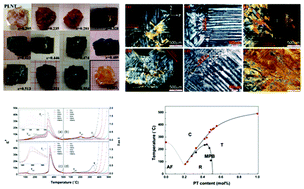A new (1 − x)Pb(Lu1/2Nb1/2)O3–xPbTiO3 binary ferroelectric crystal system with high Curie temperature
Abstract
A series of new (1 − x)Pb(Lu1/2Nb1/2)O3–xPbTiO3 (PLN–xPT) binary ferroelectric crystals with high Curie temperature have been successfully obtained firstly by top-seed solution growth technique. A solid-state phase diagram in the low temperature range has been established based on the form of single crystals, which reveals a morphotropic phase boundary (MPB) in the range of 49–51% PT. The polarized light microscope analysis also confirms the coexistence of rhombohedral and tetragonal phase within the MPB. Furthermore, those compositions within MPB exhibit good comprehensive piezoelectric properties. For example, the crystal with composition PLN–0.49PT, showing high Curie temperature Tc = 360 °C and high rhombohedral–tetragonal phase transition temperature TRT = 110 °C, and the piezoelectric coefficient d33, electromechanical coupling coefficient k33, coercive field Ec and remanent polarization Pr are found to be 1630 pC N−1, 81%, 13.8 kV cm−1 and 26.6 μC cm−2, respectively. The large coercive field and high Tc make it a promising candidate for high power transducers in a wider temperature range.


 Please wait while we load your content...
Please wait while we load your content...